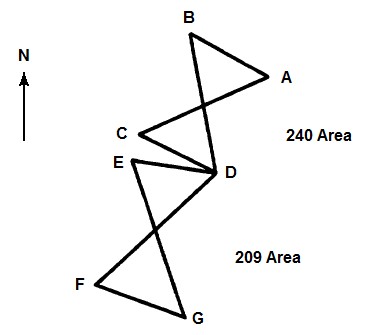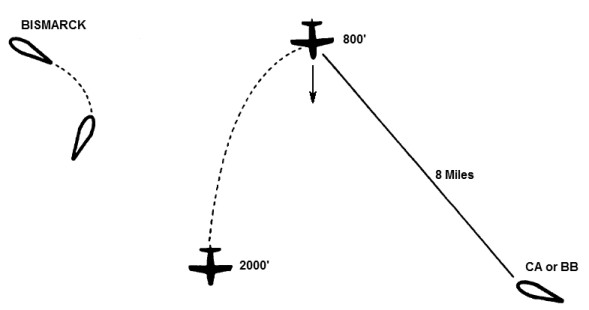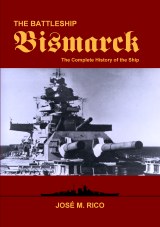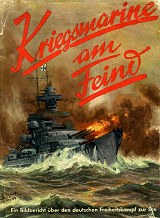REPORT OF THE SCOUTING AND SEARCH FOR BISMARCK BY ENSIGN SMITH
ISSUED BY THE INTELLIGENCE DIVISION
OFFICE OF CHIEF OF NAVAL OPERATION
NAVY DEPARTMENT
INTELLIGENCE REPORT
| Serial 1066 From: Naval Attache at London, England Source: Personal Observation & Experience |
Monograph Index Guide No. 1005-600 Date: 9 June, 1941 Evaluation: Reliable |
Subject GREAT BRITAIN AVIATION Scouting & Search by PBY-5.
Report of Scouting and Search of PBY-5 No. AH545 "Catalina" for Bismarck 26 May, 1941.
1. Following 0325 take-off from Lough Erne, it was necessary to climb to 3000' through overcast before proceeding to West Coast of Ireland. We took departure at 0430 from Eagle Island, altitude 500' on westerly course. Weather conditions were undesirable, ceiling varying from 100' to 1000' and visibility ranging from 5 miles to zero. Wind 30-35 from N.W. which reduced ground speed to approximately 80 knots.
2. The plane carried four depth charges (500 lbs. each) and capacity gas load (1750 U.S. gallons). Aircraft at Lough Erne are always armed with depth charges and the British felt it a waste of time and effort to remove them before this flight. There is no special (ASV) equipment aboard.
3. The trip to the assigned search area was uneventful other than several course changes which were necessitated by weather conditions. We arrived at our area at 0945 and immediately started search. Following is a diagram of sectors assigned to Squadrons 209 & 240 from Lough Erne.
One aircraft from each squadron was to cover each sector, ours (209) being DEFG. I assume that similar areas were assigned to other groups in order to cover all western approaches of Europe. Upon examination, it will be found that in reality this area (DEFG) is two of our familiar "Pie shaped" Vectors joined at the vertex. Flight plan. Search leg DE; EG; GF; FD and repeat.

4. Weather at search area was somewhat better than that encountered on trip out. Horizontal visibility below 800' was good up to 8-10 miles. Misty conditions prevailed between 800' and 2000' where cloud lane covered 5/6 of sky. Visibility between 800-2000 was about 4 miles and at 2000 about 1-2 miles.
5. We started leg EG of area at 1000 and at 1010 I sighted what was first believed to be Bismarck, bearing 345 at 8 miles. Definite recognition was impossible at the time due to visibility. I immediately took control from "George" (automatic pilot); started slow climbing turn to starboard, keeping ship sited to Port, while the British officer [Dennis Briggs] went aft to prepare contact report. My plan was to take cover in the clouds, get close to the ship as possible; making definite recognition and then shadow the ship from best point of vantage. Upon reaching 2000' we broke out of a cloud formation and were met by a terrific anti-aircraft barrage from our starboard quarter.

Immediately jettisoned the depth charges and started violent evasive action which consisted of full speed, climbing and "S" turns. The British officer went aft again to send the contact report. When making an "S" turn I could see the ship was a BB [battleship] and was the Bismarck, which had made a 90 starboard turn from its original course, (This was evident from wake made by his maneuvering), and was firing broadsides at us. The A.A. [anti-aircraft] fire lasted until we were out of range and into the clouds. It was very intense and were it not for evasive action we would have been shot down. The barrage was so close that it shook the aircraft considerably (one man was knocked from his bunk) and the noise of the burst could be hear above the propeller and engine noise. Numerous bursts were observed at close quarters and small fragments of shrapnel could be heard hitting the plane. The fitter came forward to pilots compartment saying we were full of holes. As soon as we were well clear of Bismarck we investigated the damage, which consisted of a hole in after port hull (about 2" in diameter) and one in bottom hull directly below instrument panel (about 1" in diameter). No other damage was visible at the time. I made short flight test (several turns, checked engines, etc) and finding everything satisfactory returned to area to resume shadow of Bismarck.
6. From this encounter it was obvious that there were two German warships in company on same course (140 true) and the leading ship was not identified but was of BB or CV [aircraft carrier] class.
7. The 240 squadron plane had intercepted our contact report and set is course to intercept the ship from the position given in our contact.
8. As we had lost contact with the ship we returned to position of the Bismarck. The navigation was somewhat in error, due to evasive action, etc., and we could not find the ship the second time. According to reports that we intercepted from 240 plane, he was being attacked by enemy aircraft. We immediately set course to intercept him. We joined up with him and he was in contact with Bismarck. We stayed in company for 45 minutes and then took departure for Lough Erne at 1530; the time specified by Group Operations Officer.
9. We landed at 2130 with approximately 250-300 gal. of gasoline remaining.
Conclusion and Recommendations.
10. On a mission of this nature, after contact has been made and reported, a torpedo attack by a patrol plane is entirely feasible. In any event, it would have been better to carry a torpedo in lieu of depth charges. The Bismarck evidently had some type of aircraft detector device. This is evident by the fact that she had turned 90 and opened fire on us as we emerged from a cloud and had thus known our position before actual sighting us.
Prepared by [signed] Leonard B. Smith, Ensign, U.S. Navy.
Forwarded by: [signed] C.A. LOCKWOOD, Jr., Capt., USN., Naval Attache.

Copyright © 1998-2025 KBismarck.com


